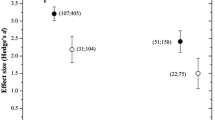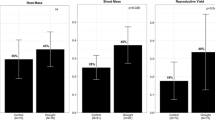Abstract
Arbuscular mycorrhizas (AM) are ubiquitous root symbioses with often pervasive effects on the plant host, one of which may be above- and belowground biomass allocation. A meta-analysis was conducted on 516 trials that were described in 90 available articles to examine whether AM colonization could result in a modification of partitioning of plant biomass in shoots and roots. It was hypothesized that alleviating plant nutrient limitations could result in a decrease of root to shoot (R/S) ratio in AM plants or, alternatively, the direction of shifts in the R/S ratio would be determined by the changes in total dry biomass. In our analysis, we considered four types of stresses: drought stress, single heavy metal stress, multiple heavy metal stress, and other potential abiotic plant stress factors. When disregarding any factors that could regulate effects, including stress status and mode of propagation, the overall AM effect was a significant modification of biomass towards shoot growth. However, the responses of stressed and clonally propagated plants differed from those of seed-grown unstressed plants. Our meta-analysis detected a considerable decline in the R/S ratio when plants were grown from seeds in the absence of abiotic stresses. Moreover, we demonstrate that additional regulators of the AM-mediated impact on R/S ratio were presence of competition from other plants, plant growth outcome of the symbiosis, growth substrate volume, experimental duration, and the identities of both plant and AM fungus. Our results indicate that a prediction of AM effects on R/S allocation becomes more accurate when considering regulators, most notably propagation mode and stress. We discuss possible mechanisms through which stress and other regulators may operate.




Similar content being viewed by others
References
Adams DC, Gurevitch J, Rosenberg MS (1997) Resampling tests for meta-analysis of ecological data. Ecology 78:1277–1283
Augé RM (2001) Water relations, drought and vesicular–arbuscular mycorrhizal symbiosis. Mycorrhiza 11:3–42
Bernier PY, Lamhanedi MS, Simpson DG (1995) Shoot:root ratio is of limited use in evaluating the quality of container conifer stock. Tree Planters’ Notes 46:102–106
Borenstein M, Hedges LV, Higgins JPT, Rothstein HR (2009) Introduction to meta-analysis. Wiley, New York
Chaudhary VB, Walters LL, Bever JD, Hoeksema JD, Wilson GWT (2010) Advancing synthetic ecology: a database system to facilitate complex ecological meta-analyses. B Ecol Soc Am 91:235–243
Conover WJ (1980) Practical nonparametric statistics. Wiley, New York
Curtis PS, Wang X (1998) A meta-analysis of elevated CO2 effects on woody plant mass, form and physiology. Oecologia 113:299–313
Davies FT Jr, Calderon CM, Hueman Z (2005) Influence of arbuscular mycorrhizae indigenous to Peru and a flavonoid on growth, yield, and leaf elemental concentration of “Yangay” potatoes. Hortscience 40:381–385
Farrar JF, Gunn S (1998) Allocation: allometry, acclimation—and alchemy? In: Lambers H, Poorter H, van Vuuren MMI (eds) Inherent variation in plant growth. Physiological mechanisms and ecological consequences. Backhuys, Leiden, pp 183–198
Fitter AH (2005) Darkness visible: reflections on underground ecology. J Ecol 93:231–243
Göhre V, Paszkowski U (2006) Contribution of the arbuscular mycorrhizal symbiosis to heavy metal phytoremediation. Planta 223:1115–1122
Gurevitch J, Hedges LV (1999) Statistical issues in ecological meta-analysis. Ecology 80:1142–1149
Haolin G, Yuhui W, Fengyu W, Bingrui J (2008) Dynamics of root–shoot ratio and environmental effective factors of recovering Leymus chinensis steppe vegetation in Inner Mongolia, China. Acta Ecol Sinica 28:4629–4634
Harris RW (1992) Root–shoot ratios. J Agr 18:39–42
Hart MM, Reader RJ (2002) Taxonomic basis for variation in the colonization strategy of arbuscular mycorrhizal fungi. New Phytol 153:335–344
Hermans C, Hammond JP, White PJ, Verbruggen N (2006) How do plants respond to nutrient shortage by biomass allocation? Trends Plant Sc 11:610–617
Hoeksema JD, Forde SE (2008) A meta-analysis of factors affecting local adaptation between interacting species. Am Nat 171:275–290
Hoeksema JD, Chaudhary VB, Gehring CA, Johnson NC, Karst J, Koide RD, Pringle A, Zabinski C, Bever JD, Moore JC, Wilson GWT, Klironomos JN, Umbanhowar J (2010) A meta-analysis of context dependency in plant response to inoculations with mycorrhizal fungi. Ecol Let 13:394–407
Hooker JE, Munro M, Atkinson D (1992) Vesicular–arbuscular mycorrhizal fungi induced alteration in poplar root system morphology. Plant Soil 145:207–214
Jacoby W (2000) Loess: a nonparametric, graphical tool for depicting relationships between variables. Elect Stud 19:577–613
Jakobsen I, Abbot LK, Robson AD (1992) External hyphae of vesicular–arbuscular mycorrhizal fungi associated with Trifolium subterraneum L. 1. Spread of hyphae and phosphorus inflow into roots. New Phytol 120:371–380
Klironomos JN, Hart MM (2002) Colonization of roots by arbuscular mycorrhizal fungi using different sources of inoculum. Mycorrhiza 12:181–184
Körner C (1994) Biomass fractionation in plants: a reconsideration of definitions based on plant functions. In: Roy J and Garnier E (eds) A whole plant perspective on carbon–nitrogen interactions. SPB Academic Publishing, The Hague, pp. 173–185
Ledig FT, Perry TO (1966) Physiological genetics of the shoot–root ratio. In Proceedings of the Society of American Foresters, Society of American Foresters, Washington DC, pp. 39–43
Lekberg Y, Koide RT (2005) Is plant performance limited by abundance of arbuscular mycorrhizal fungi? A meta-analysis of studies published between 1988 and 2003. New Phytol 168:189–204
Mamolos AP, Elisseou GK, Veresoglou DS (1995) Depth of root activity of coexisting grassland species in relation to N and P additions, measured using nonradioactive tracers. J Ecol 83:643–652
Monk C (1966) Ecological importance of root/shoot ratios. Bull Torrey Bot Club 93:402–406
Murphy GP, Dudley SA (2007) Above- and below-ground competition cues elicit independent responses. J Ecol 95:261–272
Nuortila C, Kytöviita M-M, Tuomi J (2004) Mycorrhizal symbiosis has contrasting effects on fitness components in Campanula rotundifolia. New Phytol 164:543–553
Pérez M, Urcelay C (2009) Differential growth response to arbuscular mycorrhizal fungi and plant density in two wild plants belonging to contrasting functional types. Mycorrhiza 19:517–523
Poorter H, Nagel O (2000) The role of biomass allocation in the growth response of plants to different levels of light, CO2, nutrients and water: a quantitative view. Aust J Plant Physiol 27:595–607
Powell JR, Parrent JL, Hart MM, Klironomos JN, Rillig MC, Maherali H (2009) Phylogenetic trait conservatism and the evolution of functional trade-offs in arbuscular mycorrhizal fungi. P Roy Soc B Biol Sci 276:4237–4245
Puppi G, Azcón R, Höflich G (1994) Management of positive interactions of arbuscular mycorrhizal fungi with essential groups of soil microorganisms. In: Gianinazzi S, Schüepp H (eds) Impact of arbuscular mycorrhizas on sustainable agriculture and natural ecosystems. Birkhäuser, Basel, pp 201–215
Rabie GH (2005) Influence of arbuscular mycorrhizal fungi and kinetin on the response of mungbean plants to irrigation with seawater. Mycorrhiza 15:225–230
Rasse DP, Rumpel C, Dignac M-F (2005) Is soil carbon mostly root carbon? Mechanisms for a specific stabilization. Plant Soil 269:341–356
Reynolds HL, D’Antonio C (1996) The ecological significance of plasticity in root weight ratio in response to nitrogen: opinion. Plant Soil 185:75–97
Robinson D, Davinson H, Trinder C, Brooker R (2010) Root–shoot growth responses during interspecific competition quantified using allometric modelling. Ann Bot (London) 106:921–926
Roosens N, Verbruggen N, Meerts P, Ximenez-Embun P, Smith JAC (2003) Natural variation in cadmium tolerance and its relationship to metal hyperaccumulation for seven populations of Thlaspi caerulescens from western Europe. Plant Cell Environ 26:1657–1672
Rosenberg NJ, Adams DC, Gurevitch J (2000) MetaWin: statistical software for meta-analysis version 2.0. Sinauer, Sunderland
Schroeder MS, Janos DP (2005) Plant growth, phosphorus nutrition, and root morphological responses to arbuscular mycorrhizas, phosphorus fertilization, and intraspecific density. Mycorrhiza 15:203–216
Schüßler A, Schwarzott D, Walker C (2001) A new fungal phylum, the Glomeromycota: phylogeny and evolution. Mycol Res 105:1413–1421
Sikes BA, Powell JR, Rillig MC (2010) Deciphering the relative contributions of multiple functions within plant–microbe symbiosis. Ecology 91:1591–1597
Smith SE, Read DJ (2008) Mycorrhizal symbiosis. Elsevier Science, New York, p 605
Stevens CJ, Maskell LC, Smart SM, Caporn SJM, Dise NB, Gowing DJG (2009) Identifying indicators of atmospheric nitrogen deposition impacts in acid grasslands. Biol Conserv 142:2069–2075
Van Den Noortgate W, Onghena P (2005) Parametric and nonparametric bootstrap methods for meta-analysis. Behav Res Method 37:11–22
van der Heijden MGA, Klironomos JN, Ursic M, Moutoglis P, Streitwolf-Engel R, Bolle T, Wiemken A, Sanders IR (1998) Mycorrhizal fungal diversity determines plant biodiversity, ecosystem variability and productivity. Nature 396:69–72
Veresoglou SD, Menexes G (2010) Impact of inoculation with Azospirillum spp. on growth properties and seed yield of wheat: a meta-analysis of studies in the ISI Web of Science from 1981 to 2008. Plant Soil 337:469–480
Wang X, Ngigi AR, Smith DL, McPeek TM (2008) Biomass responses to interspecific competition differ between wild species and CO2. J Plant Ecol 1:25–32
Wilson SD, Tilman D (1995) Competitive responses of 8 old-field plant-species in 4 environments. Ecology 76:1169–1180
Yao Q, Wang LR, Zhu HH, Chen JZ (2009) Effects of arbuscular mycorrhizal fungal inoculation on root system architecture of trifoliate orange (Poncirus trifoliata L. Raf.) seedlings. Sci Hortic Amst 121:458–461
Zandavalli RB, Dillenburg LR, de Souza PVD (2004) Growth responses of Araucaria angustifolia (Araucariaceae) to inoculation with the mycorrhizal fungus Glomus clarum. Appl Soil Ecol 25:245–255
Acknowledgements
The project was funded through an award to Stavros Veresoglou from Freie Universität Berlin, Center for International Cooperation. We are grateful to two anonymous referees for their constructive comments.
Author information
Authors and Affiliations
Corresponding author
Rights and permissions
About this article
Cite this article
Veresoglou, S.D., Menexes, G. & Rillig, M.C. Do arbuscular mycorrhizal fungi affect the allometric partition of host plant biomass to shoots and roots? A meta-analysis of studies from 1990 to 2010. Mycorrhiza 22, 227–235 (2012). https://doi.org/10.1007/s00572-011-0398-7
Received:
Accepted:
Published:
Issue Date:
DOI: https://doi.org/10.1007/s00572-011-0398-7




